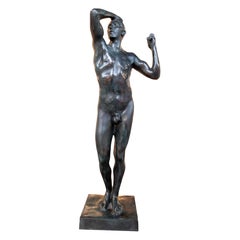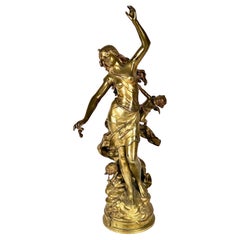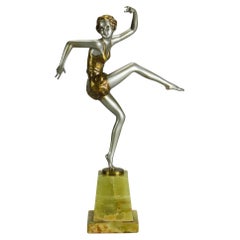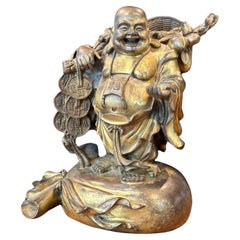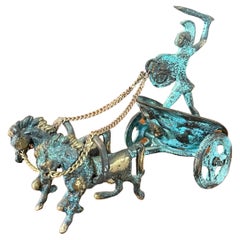Bronze Figurative Sculptures
to
575
4,249
181
110
91
1,714
2,444
291
923
558
490
129
60
209
120
60
77
76
86
108
84
575
256
248
204
180
93
69
49
32
27
19
15
12
8
5
5
1
7,260
4,540
3,915
3,588
2,863
2,142
1,981
3,226
1,811
494
413
350
Height
to
Width
to
4,540
4,407
4,446
50
28
27
27
25
Material: Bronze
1970s Bronze Sculpture of a Nude Man, Signed.
Located in Marbella, ES
Magnificent bronze sculpture, with a visible signature on the base. The work depicts a standing male nude in an upright and dynamic posture, with one hand raised to his forehead, evo...
Category
Late 20th Century Bronze Figurative Sculptures
Materials
Bronze
Gilt Bronze Sculpture by Auguste Moreau “Nuit d'Été ”, France 1894
Located in LA CIOTAT, FR
"Nuit d’été",
dated 1894 and signed by Louis-Auguste MOREAU
Famous French sculptor, 1855-1919
A superb French parcel gilt patinated bronze group depicting a semi-clad maiden on n...
Category
19th Century French Antique Bronze Figurative Sculptures
Materials
Bronze
Early 20th Century Bronze Sculpture entitled "Con Brio" by Josef Lorenzl
Located in London, GB
An attractive early 20th Century Art Deco cold painted bronze figure of a young energetic beauty in a dancing pose, exhibiting excellent colour and very fine hand chased surface deta...
Category
Early 20th Century Austrian Art Deco Bronze Figurative Sculptures
Materials
Onyx, Bronze
Mid-Century Traditional Bronze Hotei / "Happy Buddha" Wandering Monk Sculpture
Located in San Diego, CA
A well cast mid-century traditional bronze "Happy Buddha" wandering monk sculpture, circa 1970s. The piece is in very good vintage condition and measures: 9"W x 6.5" D x 10" H. The ...
Category
Mid-20th Century American Mid-Century Modern Bronze Figurative Sculptures
Materials
Bronze
Verdigris Bronze Greek Chariot Sculpture with Trojan Warrior
Located in San Diego, CA
A cool verdigris bronze horse and chariot sculpture with trojan warrior from Greece, circa 1970s. The piece is in very good vintage conditione...
Category
20th Century Greek Mid-Century Modern Bronze Figurative Sculptures
Materials
Bronze
$160 Sale Price
20% Off
Wooly Chaps Bronze Sculpture on Marble Base, after Frederic Remington
Located in Yonkers, NY
Wooly Chaps, a cast bronze sculpture after American artist Frederic Remington on marble base. A variation of his most famous sculpture, The Broncho Buster, Wooly Chaps is filled with a tremendous dramatic tension and depicts a scene from the American Old West...
Category
20th Century Bronze Figurative Sculptures
Materials
Marble, Bronze
Art Deco Bronze Sculpture Scarf Dancer by R. Varnier 1925
By R. Varnier
Located in Antwerp, BE
A captivating Art Deco bronze sculpture titled Scarf Dancer, created by the French artist R. Varnier circa 1925. This elegant figure captures the grace and movement of a dancer mid-p...
Category
1920s French Art Deco Vintage Bronze Figurative Sculptures
Materials
Marble, Belgian Black Marble, Bronze
Antique/Vintage Gothic Altar Table Crucifix, Brass /Bronze Table Standing Cross
Located in Skien, NO
Richly Decorated Free-Standing Table Crucifix / Cross & Corpus of Christ from the first half of the 20th century.
Gothic style, crafted from brass/bronze, with a beautiful patina. I...
Category
20th Century European Gothic Revival Bronze Figurative Sculptures
Materials
Brass, Bronze
$576 Sale Price
20% Off
Bronze, 2 Young Children Riding on Sled on Carved White Marble Base ca. 1895
Located in Petaluma, CA
This whimsical little bronze shows 2 young children on a sled riding down a hill of snow and with one youngster waving to us. The bronze is finished in gilt and the sled is mounted on carved marble. That is marble, not alabaster, and if you ever tried to dig your thumb nail into marble vs. alabaster you will see how much harder that stone is comparatively. The bronze is signed by the noted German artist Paul Ludwig Kowalczewski...
Category
Late 19th Century German Belle Époque Antique Bronze Figurative Sculptures
Materials
Marble, Bronze
E. H. Dumaige Patinated Bronze Figure of a Muse
Located in Astoria, NY
Etienne-Henri Dumaige (French, 1830-1888) Patinated Bronze Sculpture of a Dancing Muse, late 19th century, the draped dancing figure upholding a tambourine on a rectangular plinth, s...
Category
Late 19th Century Neoclassical Antique Bronze Figurative Sculptures
Materials
Bronze
Large Bronze Statue 3 Horse Rider Hunt Scene after Evgeni Alexandrovich Lanceray
Located in Philadelphia, PA
Large Bronze Statue 3 Horse Rider Hunt Scene after Evgeni Alexandrovich Lanceray. Item features a large impressive size, marked to base, believed to be a 20th Century reproduction of...
Category
Late 20th Century Unknown Other Bronze Figurative Sculptures
Materials
Bronze
Vienna Cold Painted Bronze Ten Piece Devil Orchestra, Attributed Franz Bergman
Located in West Palm Beach, FL
Vienna Cold Painted Bronze Ten Piece Devil Orchestra, Attributed Franz Bergman
Austria, circa 1925, attributed to Franz Bergman, unmarked
Embark on a whimsical journey with this rare and delightful Vienna Cold Painted Bronze Ten Piece Devil Orchestra, made circa 1925 and attributed to the renowned Franz Bergman, though unmarked. This charming ensemble features ten individually cast and hand-painted bronze figures, each devil bearing its own instrument and unique action.
From the authoritative Conductor Devil to the playful Flute Devil, every character in this orchestra exudes personality and mischief. The ensemble includes the Piano Devil, Cello Devil, Drum Devil, Heraldic Trumpet...
Category
Early 20th Century Austrian Belle Époque Bronze Figurative Sculptures
Materials
Bronze
$2,360 Sale Price / set
20% Off
18th C. Tibetan Gilt Bronze Green Tara Buddha Statue
Located in Dallas, TX
A Gilt Bronze Tibetan Representation Of A rare Green Tara Buddha Statue. Sounds like there is an item sealed inside.
Gilt Bronze and Copper.
Early 1...
Category
1790s Tibetan Tibetan Antique Bronze Figurative Sculptures
Materials
Bronze
Large Bronze Sculpture Apollo & Daphne, After Giovanni Gian Lorenzo Bernini
By Bernini
Located in New York, NY
Large Bronze Sculpture Apollo & Daphne, After Giovanni Gian Lorenzo Bernini (Italian, 1598–1680)
This large bronze sculpture depicts the mythological figures Apollo and Daphne at th...
Category
1870s Italian Rococo Antique Bronze Figurative Sculptures
Materials
Bronze
Early 20th Century Bronze Sculpture of Male Athlete by Donato Barcaglia, Italy
Located in North Miami, FL
Early 20th century patinated bronze sculpture of male Athlete by Donato Barcaglia, Italy
By: Donato Barcaglia
Material: bronze, copper, tin, metal
Technique: cast, molded, patinated...
Category
Early 1900s Italian Belle Époque Antique Bronze Figurative Sculptures
Materials
Metal, Bronze, Copper, Tin
Monumental Emile Louis Picault Signed Egyptian Revival Pharaoh Sculptures, Pair
Located in Forney, TX
A spectacular matched pair of large and extremely rare Emile Louis Picault cold painted bronze sculptures from the late 19th century.
Exquisitely handcrafted in France, circa 189...
Category
19th Century French Egyptian Revival Antique Bronze Figurative Sculptures
Materials
Bronze
Greco Roman Style Vintage Verde Bronze Statue of a Male Nude with Grapes in Hair
Located in Yonkers, NY
A vintage Greco-Roman style bronze nude statue from the 20th century with verde patina and wooden pedestal base. Created with the traditional technique o...
Category
20th Century Greco Roman Bronze Figurative Sculptures
Materials
Bronze
Demetre Haralamb Chiparus (1886 - 1947), Art Deco Dancer Bronze Sculpture
Located in Germantown, MD
Demetre Haralamb Chiparus (French/Romanian 1886 - 1947), Art Deco Dancers, Bronze Sculpture On Marble Plinth.
Demétre H Chiparus Antique Bronze Art Deco Dancer...
Category
Early 20th Century French Art Deco Bronze Figurative Sculptures
Materials
Marble, Bronze
Art Deco bronze sculpture of a panther by Rulas France 1930
By Rulas
Located in Antwerp, BE
Art Deco bronze sculpture of a panther signed Rulas.
Bronze gold patina, on a Belgian Black base.
Signed and marked Bronze.
Ca. 1930
Category
1930s French Art Deco Vintage Bronze Figurative Sculptures
Materials
Belgian Black Marble, Bronze
Art Deco sculpture bronze panther signed by Charles Conrad.
By Charles Conrad
Located in Antwerp, BE
Art Deco sculpture bronze panther signed by Charles Conrad.
Foundry seal of Deroyaume fondeur.
Model designed ca. 1935.
Cast in 2008.
Bronze with black patina.
Literature:
Dictio...
Category
Early 2000s French Art Deco Bronze Figurative Sculptures
Materials
Bronze
Antique Signed August Moreau Bronze Cherub and Flowers Vase on Marble Base
Located in Keego Harbor, MI
An August Moreau bronze table sculpture. This lovely art nouveau table sculpture features a full cast bronze construction, sitting atop a beautiful tapered marble base. This vase dep...
Category
Late 20th Century Unknown Modern Bronze Figurative Sculptures
Materials
Marble, Bronze
Mid-Century Modern Bronze Set of Japanese Women Awa Odori Dancers
Located in San Diego, CA
Beautiful set of 4 bronze dancer figures. This group of 4 petite figures have graceful lines and a beautiful golden finish with patina. Circa 1950s. These abstract figures with a variegated gold patina depict female Japanese Awa Odori...
Category
1950s Japanese Chinoiserie Vintage Bronze Figurative Sculptures
Materials
Bronze
$316 Sale Price / set
20% Off
"Seated Male Nude, " Remarkable Bronze Sculpture by Choate, Figural Artist
Located in Philadelphia, PA
Although America's sculptors interested in African American life and Black subjects, including Elizabeth Catlett, Richmond Barthé, Sargent Johnson and ...
Category
1950s American Mid-Century Modern Vintage Bronze Figurative Sculptures
Materials
Bronze
$14,000 Sale Price
20% Off
"Mercury with the Golden Blade", 1921 Bronze Sculpture with Male Nude, Austria
Located in Philadelphia, PA
Powerful and very rare, this sculpture of a kneeling, fully nude Mercury, with his golden blade in hand, dates from 1921 and was probably sculpted by a German or Austrian artist. Me...
Category
1920s Austrian Art Deco Vintage Bronze Figurative Sculptures
Materials
Bronze
Magnificent Benin Oba And His Queen Cast Bronzes, Lost Wax Method, Nigeria
Located in Rothley, Leicestershire
Outstanding Benin Oba and his Queen, Lost Wax 'Bronze' Sculptures from the late 20th century
Superbly cast and highly decorative contemporary pieces, not historical
The centuries ol...
Category
Late 20th Century Beninese Tribal Bronze Figurative Sculptures
Materials
Bronze
A bronze statue of a ballerina
Located in Delft, NL
A bronze statue of a ballerina
A beautiful abstract statue of a ballerina made in bronze on a rectangular base. The bronze ballerina in a beautiful pose of a dancing jump, mounted...
Category
20th Century Dutch Bronze Figurative Sculptures
Materials
Bronze
Karl Springer Standing Buddha Sculpture in Gilt Bronze 19th Century
Located in New York, NY
Beautifully made large 19th century Siam standing Buddha sculpture in gilt bronze sold through the Karl Springer showroom on custom ebonized wood ...
Category
19th Century Thai Other Antique Bronze Figurative Sculptures
Materials
Bronze, Gold Leaf
Art Deco Male Sculpture, Spelter, Marble, France circa 1930
Located in Regensburg, DE
Elegant Art Deco sculpture of an athletic scouting / watching male figure by Jean de Roncourt from France around 1930.
Very good original condition, greenish patinated Spelter / Zinc...
Category
1930s French Art Deco Vintage Bronze Figurative Sculptures
Materials
Marble, Bronze
"Male Athlete with Kettlebell", Rare Bronze Sculpture with Male Nude by Seifert
Located in Philadelphia, PA
This highly rare bronze of a nude male athlete preparing to left a heavy kettlebell weight was sculpted by an Austrian artist, Franz Seifert, in 1922. Although Seifert is known for his nude figures straining to accomplish physical tasks -- such as carrying a large bucket or splitting a stone -- this sculpture is the only example known to exist. A decade after this sculpture was cast, Seifert carved a marble portrait of Siegfried Marcus, inventor of the gasoline-powered car, for a monument in Vienna, which includes a nude male figure in bas relief racing forward on the upper edge of an automobile wheel. He also created a large sculpture grouping honoring Empress Elizabeth...
Category
1920s Austrian Art Deco Vintage Bronze Figurative Sculptures
Materials
Bronze
20th Century Large Patinated Bronze Sculpture of a Seated Nude Lady, Signed
Located in Germantown, MD
20th Century Large Patinated Bronze Sculpture of a Seated Nude Lady.
Excellent quality. Measures 12" in width, 12" in depth and 16" in height.
Category
Mid-20th Century Unknown Greco Roman Bronze Figurative Sculptures
Materials
Bronze
Gilt And Silvered Bronze Table Ornament With Putti And Urn
Located in Norwood, NJ
Eugene Provost (1836-1885) France, 19th century, a charming gilt and silvered bronze sculpture depicting two putti moving a chariot with grapes and vines, on a rectangle shaped base.
Category
Late 19th Century French Louis XVI Antique Bronze Figurative Sculptures
Materials
Bronze
Large and Heavy of Bronze Horse Sculpture
Located in Norton, MA
United States, 20th Century
Depicts a bucking horse with a flowing mane and tail-mounted on a round green marble base.
Category
20th Century American Other Bronze Figurative Sculptures
Materials
Marble, Bronze
P.J. Mene The Hunt Scene Large Bronze Sculpture Pierre Jules Statue Horse Dogs
Located in Philadelphia, PA
P.J. Mene The Hunt Scene Large Bronze Sculpture Pierre Jules Statue Horse Dogs. Item featured is signed to base, "P.J. Mene 1869", artist Pierre Jules Mene, large impressive size, re...
Category
Late 19th Century Unknown Other Antique Bronze Figurative Sculptures
Materials
Bronze
Diego Giacometti style bronze statue "le chat maitre d'hotel" France 1970
By Diego Giacometti
Located in Paris, FR
Diego Giacometti style bronze statue "le chat maitre d'hotel" made in France around 1970
The Butler Cat, 1961-1964 is one of Diego Giacometti's most iconic works. He created it in ...
Category
Mid-20th Century French Mid-Century Modern Bronze Figurative Sculptures
Materials
Bronze, Metal
Maison Jansen Huge 5 Light Bamboo Bronze & Brass Palm Tree Floor Lamp Paris 1965
Located in Miami, FL
One of a Kind Maison Jansen designed 7ft H bronze, brass and bamboo palm tree floor lamp made in 1965.
Provenance: Palace Hotel in La Baule, France.
Wired f...
Category
1960s French Mid-Century Modern Vintage Bronze Figurative Sculptures
Materials
Brass, Bronze
$14,320 Sale Price
20% Off
Large Life-size South Asian Nepali Gilded Patinated Brass Buddha Head Statue
Located in Forney, TX
A fine quality and visually striking life-size Nepalese Buddha head with beautifully aged warm patina.
Exceptionally executed in brass/bronze with brilliant gold gilt / antique cop...
Category
20th Century South Asian Bronze Figurative Sculptures
Materials
Brass, Bronze
Bronze Figurine Sculpture Hoop Dancer After D H Chiparus, Art Deco Circa 1920s
Located in Lincoln, Lincolnshire
This is a solid bronze figurine of a dancing lady called Hoop Girl after D H Chiparus, on an Onyx base, dating to the Art Deco period, Circa 1925 to 1935.
...
Category
1920s French Art Deco Vintage Bronze Figurative Sculptures
Materials
Onyx, Bronze
Francois Rude "The Education of Achilles" Bronze
By Francois Rude
Located in Astoria, NY
After Francois Rude (French, 1784-1855) "The Education of Achilles by the Centaur Chiron" Patinated Bronze Sculpture, late 19th century, unsigned, elements missing. 17" H x 17.5" W x...
Category
Late 19th Century French Belle Époque Antique Bronze Figurative Sculptures
Materials
Bronze
Victor Salmones Bronze Sculpture Titled "La Cuerda Floja" Signed & Number 6/10
Located in Los Angeles, CA
Stunning bronze sculpture envisioned and executed in Puerto Vallarta, Mexico by the listed sculptor, Victor Salmones.
This limited edition Bronze Sculpture is titled "La Cuerda Floj...
Category
1980s North American Modern Vintage Bronze Figurative Sculptures
Materials
Bronze
Late 19th Century Art Nouveau Bronze figure "Slave Girl" by Emmanuel Villanis
Located in London, GB
A beautiful patinated Art Nouveau bronze study of a young Art Nouveau beauty sat upon a wall wearing chains with excellent variegated rich brown patina and excellent hand chased surf...
Category
Late 19th Century French Art Nouveau Antique Bronze Figurative Sculptures
Materials
Bronze
French Bronze Sculpture Seated Woman by Etienne-Henri Dumaige
Located in Shippensburg, PA
ETIENNE-HENRI DUMAIGE
French, 1830-1888
Classical Seated Woman with Treasure Spilling at Her Feet
Burnished and patinated bronze over original polished black marble base signed in cast "H. Dumaige Sculpt" and cold-stamped 3750 circa 1875
Item # 309OXB09P
This exquisite cast depicts a full-length seated female modeled with echoes of classical antiquity. Dumaige seeks to depict the young woman as a noble likely of the Roman Empire, her wealth an obscene display with pearls falling from her fingers almost as an afterthought over a chest of jewels with treasure spilling from the lid before her overstuffed throne with a richly decorated pillow...
Category
19th Century French Romantic Antique Bronze Figurative Sculptures
Materials
Marble, Bronze
Swan Bronze Brutalist Statue, a Pair
Located in Plainview, NY
A unique and highly decorative pair of Brutalist style swan statues in bronze both in a takeoff position. The wings are finely. Carved displaying amazing d...
Category
Mid-20th Century Brutalist Bronze Figurative Sculptures
Materials
Bronze
$2,100 / set
Large Signed Farnsworth bronze Sculpture Of Sitting Southern Gentleman
Located in Los Angeles, CA
Large Bronze southern Gentleman sculpture in original paint. This sculpture depicts that of a man smoking a cigar sitting on a high stool or bench with a cane in the other hand. Ther...
Category
19th Century American Adirondack Antique Bronze Figurative Sculptures
Materials
Bronze
$1,196 Sale Price
20% Off
19th Century Lifesize Bronze Bust of Othello after Gaston Veuvenot Leroux
By Gaston Vuevenot Leroux
Located in Los Angeles, CA
A large and impressive French 19th century life-size bust depicting Othello, the North African Moor of Venice character in the 1603 play written by William Shakespeare (1564-1616), a...
Category
19th Century French Moorish Antique Bronze Figurative Sculptures
Materials
Bronze
$28,950 Sale Price
35% Off
Art Deco Bronze Sculpture Bust Young Boy Achilles by Constant Roux, 1920
By Les Neveux De J. Lehmann, Constant Roux
Located in Antwerp, BE
Art Deco bronze sculpture bust young Achilles.
The bronze bust is signed by Constant Roux with foundry mark Les Neveux de Lehmann and stamped number.
The sculpture is fixed on a g...
Category
1920s French Art Deco Vintage Bronze Figurative Sculptures
Materials
Marble, Bronze
Tiffany & Co. Luca Madrassi Jeune Couple Bronze
Located in Astoria, NY
Luca Madrassi (Italian, 1848-1919) Jeune Couple, Patinated Bronze Sculpture, late 19th century, retailed by Tiffany and Company, depicting embracing lovers on a naturalistic base, st...
Category
Late 19th Century Italian Art Nouveau Antique Bronze Figurative Sculptures
Materials
Bronze
Large Bronze Dancing Shiva, Nataraja, 19th/20th Century, South India
Located in Austin, TX
A heavy and well cast South Indian bronze figure of Shiva Nataraja, or Shiva as Lord of the Dance, in the Chola style, late 19th or early 20th century, India.
Shiva is portrayed here in his form as Nataraja, the Lord of the Dance. An iconic and powerful image, Shiva is portrayed engaged in his dance of creation, protection, and destruction, bringing together all his aspects into one sublime form.
Shiva dances ecstatically, facing the viewer with his body twisted, his long locks of hair streaming out around him, his four arms in action, with one leg raised, the other stomping on the dwarf demon Apasmara, who represents spiritual ignorance.
In one hand he holds a damaru, or ritual drum...
Category
Early 1900s Indian Antique Bronze Figurative Sculptures
Materials
Bronze
D. Grisard Bronze Sculpture of a Nude Lady
Located in Guaynabo, PR
This is a gilt bronze sculpture of a happy nude lady. She is lifting her left arm/hand and holding a mirror while looking at herself in it. She is standing over a sloped shaped rock ...
Category
Early 20th Century French Art Deco Bronze Figurative Sculptures
Materials
Bronze
$596 Sale Price
25% Off
Ferdinando Vichi Marble Sculpture Sitting Woman On Pedestal
Located in Kastrup, DK
"Ferdinando Vichi", Florence 1875-1945. Romantic figure of sitting woman.
Made in marble, sitting on a chair made of bronze, original pedestal of green, Italian marble.
Sign. Vichi. Ca. in 1900.
(In two pieces)
Ferdinando Vichi (1875-1945) was a central figure in the production of Florentine sculpture...
Category
Early 20th Century Italian Renaissance Bronze Figurative Sculptures
Materials
Marble, Bronze
Amazing Gothic Revival Bronze Chandelier with Flying Phoenix Firebird Sculptures
Located in Lisse, NL
Large and remarkable, phoenix arms, five-light chandelier with unique, stylish and multi-colored alabaster shades.
This rare and stunning antique chandelier is made in France and it embodies everything that European craftsmanship stood for in the early 1900s. With all its ancient and less ancient châteaux, its many Gothic churches and with all the monasteries, France is the country where most of the European Gothic Revival art and antiques were created. This sizeable, Medieval style chandelier is very impressive for two very good reasons. First of all, the design is unlike anything you ever saw. The five large and flying phoenix sculptures with their detailed wings, their long necks, their fierce looking heads and their pointy-flame-tails truly make this chandelier a work of lighting art. Secondly, when you realize that this chandelier is entirely handcrafted and put together with bronze parts only then you get an idea of the workmanship that it took to create this work of art. To make it even more impressive and special, this antique bronze light fixture...
Category
Early 20th Century French Art Deco Bronze Figurative Sculptures
Materials
Alabaster, Bronze
Belle Époque French Bronze Sculpture of a Boy with Overall and Hat by Louis Kley
By Louis Kley
Located in North Miami, FL
Belle Époque french bronze sculpture of a boy with overall and a hat by Louis Kley
By: Louis Kley
Material: bronze, copper, metal
Technique: cast, patinated, molded, metalwork
Dimen...
Category
Late 19th Century French Belle Époque Antique Bronze Figurative Sculptures
Materials
Bronze, Metal, Copper
Bruno Zach Bronze Sculpture
By Bruno Zach
Located in Toledo, OH
Exquisite Bruno Zach (1891-1935) bronze of a semi-nude woman wearing a fringed wrap and holding a riding crop behind her back. Signed on the base near the right foot. The riding crop...
Category
Early 20th Century Bronze Figurative Sculptures
Materials
Bronze
$14,000
Bronze Sculpture of a Nude Woman, Signed Cipriani, Early 20th Century.
By Cipriani
Located in Saint-Ouen, FR
Bronze sculpture of a nude woman, signed Cipriani, early 20th century.
Sculpture signed Cipriani in patinated bronze in the Art Deco style, marble base, representing a nude woman, 1...
Category
Early 20th Century European Art Deco Bronze Figurative Sculptures
Materials
Marble, Bronze
Mid 20th Century Limited Edition Salvador Dali "Venus aux Tiroirs"
Located in London, GB
An excellent mid 20th Century limited edition bronze figure of the Venus de Milo incorporating multiple drawer compartments to her head, breasts, torso and left leg to symbolise the ...
Category
Late 20th Century Spanish Modern Bronze Figurative Sculptures
Materials
Bronze
1890s Belle Époque Bronze Sculpture 'Pêcheur' by Adolphe-Jean Lavergne, France
Located in North Miami, FL
1890s Belle Époque bronze sculpture of a young fisherman 'Pêcheur' by the sculptor Adolphe-Jean Lavergne, France
By: Adolphe-Jean Lavergne
Material: bronze, copper, metal
Technique:...
Category
1890s French Belle Époque Antique Bronze Figurative Sculptures
Materials
Metal, Bronze, Copper
Antique Grand Tour Patinated Bronze Figure of Narcissus 1870, 19th Century
Located in London, GB
This is a superb antique Grand Tour patinated bronze figure of Narcissus, dating from the last quarter of the 19th Century.
Narcissus was a hunter in Greek mythology and he was di...
Category
1870s Antique Bronze Figurative Sculptures
Materials
Bronze
Italian Minerva Patinated Bronze Sculpture
Located in Astoria, NY
After the Antique Venus of Capua Patinated Bronze Sculpture, 19th century, possibly cast by Chiurazzi, the standing draped figure with outstretched arm, with a foot resting on a helm...
Category
19th Century Italian Classical Greek Antique Bronze Figurative Sculptures
Materials
Bronze
Roman She-wolf, Grand Tour, Antique Bronze, Late 19th Century
Located in MARSEILLE, FR
Roman Wolf, large antique patinated bronze of the Capitoline she-wolf, on a green marble base.
This sculpture illustrates the legend of the founding of ...
Category
Late 19th Century Italian Classical Roman Antique Bronze Figurative Sculptures
Materials
Bronze
Giambologna "Rape of the Sabine Woman" Bronze
By Jean de Bologne
Located in Astoria, NY
After Giambologna (Jean de Boulogne, Italian, 1529-1608) "Rape of the Sabine Woman" Patinated Bronze Sculpture, French, late 19th century. 42.5" H x 12" W x 12" D. Note: This bronze ...
Category
19th Century Antique Bronze Figurative Sculptures
Materials
Bronze
"Le. Rêve"- Hippolyte François Moreau (1832-1927) Figurative Bronze Sculpture
Located in Saint-Ouen, FR
"The Dream" - Hippolyte François Moreau (1832-1927)
Figurative bronze sculpture
"The Dream", Figurative bronze sculpture with brown patina
On a rotating base bearing a cartouche en...
Category
1880s French Belle Époque Antique Bronze Figurative Sculptures
Materials
Bronze
